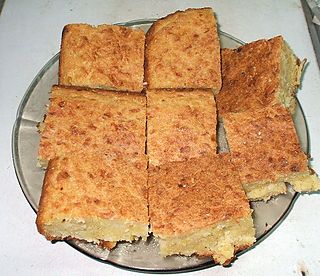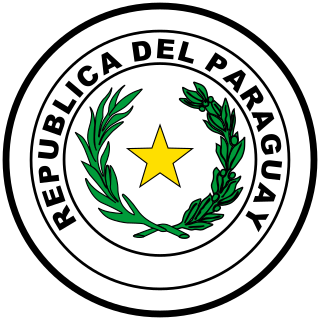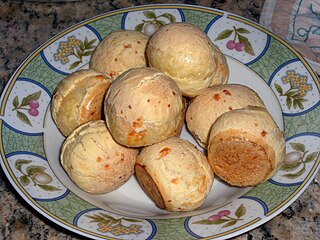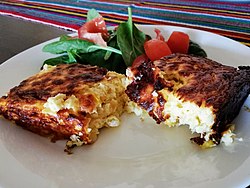
Argentine cuisine is described as a blending of cultures, from the Indigenous peoples of Argentina who focused on ingredients such as humita, potatoes, cassava, peppers, tomatoes, beans, and yerba mate, to Mediterranean influences brought by the Spanish during the colonial period. This led to cultural blending of criollos, Indigenous, and sub-Saharan African in the cuisine. Later, this was complemented by the significant influx of Italian and Spanish immigrants to Argentina during the 19th and 20th centuries, who incorporated plenty of their food customs and dishes such as pizzas, pasta and Spanish tortillas.

Latin American cuisine is the typical foods, beverages, and cooking styles common to many of the countries and cultures in Latin America. Latin America is a highly racially, ethnically, and geographically diverse with varying cuisines. Some items typical of Latin American cuisine include maize-based dishes arepas, empanadas, pupusas, tacos, tamales, tortillas and various salsas and other condiments. Sofrito, a culinary term that originally referred to a specific combination of sautéed or braised aromatics, exists in Latin American cuisine. It refers to a sauce of tomatoes, roasted bell peppers, garlic, onions and herbs. Rice, corn, pasta, bread, plantain, potato, yucca, and beans are also staples in Latin American cuisine.

Cordillera is a department in Paraguay. The capital is the city of Caacupé.
Eusebio Ayala is a city and district of the Cordillera Department, Paraguay. It is named after Eusebio Ayala, a former President of Paraguay. It is located approximately 72 km of the city of Asuncion, capital of the Republic of Paraguay.

Piribebuy is a town and district in the Cordillera Department of Paraguay. It is of spontaneous origin, though some attribute its founding to Martin Ledesma de Valderrama in 1636. Since its founding documents were burned during the Paraguayan War, March 8, 1636, was later appointed as its Day of Establishment. Piribebuy is known for its Church "Dulce Nombre de Jesus", also known as "Ñandejará Guasu," and also has a small history museum dedicated to memorabilia from the War of Triple Alliance, explaining Piribebuy's large role in the war, as well as memorabilia from the Chaco War and Colonial Times.

Luque is a city in Central Department of Paraguay, part of the Gran Asunción metropolitan area. Both 1635 and 1750 have been recorded as dates of its founding. It was temporarily the capital of Paraguay in 1868 during the Paraguayan War before relocation to San Estanislao. It is located at around 25°16′12″S57°29′14″W. Luque is one of the most important cities in the country. The city counts as home of Paraguay's main international airport, Silvio Pettirossi International Airport and the Ñu Guasú Park, which is where the Paraguayan Olympic Committee is also located. The continental governing body of association football in South America, CONMEBOL, has its headquarters approximately 3 minutes from the Airport, consisting of the South American Football Museum and walking distance from the Bourbon CONMEBOL Asunción Convention Hotel. When it existed, ARPA – Aerolíneas Paraguayas had its headquarters in the ARPA Terminal on the grounds of the airport. It is a center of production of Guitars and Paraguayan harps as well as Filigranas, gold and silver filigree jewelry including the seven-band ring Carretón de Siete Ramales. On 27 January 2016, Paraguayan Newspaper La Nación had reported that Carlos Echeverría Estigarribia, the elected intendent of the city of Luque, states his intention of wanting Luque to be one of the most important cities.

Chipa is a type of small, baked, cheese-flavored rolls, a popular snack and breakfast food in Paraguay. The recipe has existed since the 18th century and its origins lie with the Guaraní people of Asunción. It is inexpensive and often sold from streetside stands and on buses by vendors carrying a large basket with the warm chipa wrapped in a cloth.

Sopa paraguaya is a traditional food of the Paraguayan cuisine similar to corn bread. Corn flour, cheese, onion and milk or whey are common ingredients. It is a spongy cake rich in caloric and protein content.

The culture of Paraguay reflects the Spanish and indigenous influences of the country. Paraguay's cultural heritage can be traced to the extensive intermarriage between the original male Spanish settlers and indigenous Guaraní women. Their culture is highly influenced by various European countries, including Spain. Therefore, Paraguayan culture is a fusion of two cultures and traditions; one European, the other, Southern Guaraní. More than 93% of Paraguayans are mestizos, making Paraguay one of the most homogeneous countries in Latin America. A characteristic of this cultural fusion is the extensive bilingualism present to this day: more than 80% of Paraguayans speak both Spanish and the indigenous language, Guaraní. Jopara, a mixture of Guaraní and Spanish, is also widely spoken.

Vori vori is a thick, yellow soup with little balls made of corn flour, and cheese, and it's traditional of the Paraguayan cuisine. It is essentially of Cario-Guarani and Sephardic origins, and derives from one of the commemorative dishes of the Passover as it derives from the Matza balls, replacing the wheat semolina with the corn flour of the Carios.

Mbeju is a starch cake sometimes made with fariña or manioc flour typical of Paraguay. The recipe has existed since the 18th century and its origins lie with the indigenous Cario-Guarani people that lived in the Asunción and its surroundings.

Atyrá is one of the oldest cities of Paraguay, alongside Yaguarón, Villarrica, Encarnación, Pilar, San Lorenzo, Humaitá among others. Atyrá is 61 KM East from the country's capital, Asunción, located in the Altos Cordillera, as it is part of the Cordillera Department, in Central Paraguay.
Guarambaré is a town in the Central Department of Paraguay. Guarambaré was the name of a Guaraní tribe in North-Eastern Paraguay at the time of the founding of the Spanish colony during the 16th century. A Franciscan reduction was founded between 1580 and 1600 in the modern-day department of Concepción, south of the river Aquidabán. The reduction was relocated in 1673 to the current location, south-east of Asunción.
Long before Spanish conquistadors discovered Paraguay for King Charles V in 1524, semi-nomadic Chaco Indian tribes populated Paraguay's rugged landscape. Although few relics or physical landmarks remain from these tribes, the fact that nearly 90 percent of Paraguayans still understand the indigenous Guarani language is testament to Paraguay's Indian lineage. The Spanish conquistadors arrived in 1524 and founded Asunción in 1537. Paraguay's colonial experience differed from that of neighboring countries, such as Bolivia and Argentina, because it did not have gold and other mineral deposits that the Spanish were searching for. Because of its lack of mineral wealth and its remoteness, Paraguay remained underpopulated and economically underdeveloped. Early governor Domingo Martínez de Irala took an Indian wife and a series of Indian concubines and encouraged other male settlers to do likewise. Intermarriage fused Indian culture with that of the Europeans, creating the mestizo class that dominates Paraguay today. From the beginning, however, Indians retained their Guaraní language, even as Spanish influence was accepted, and embraced, in other aspects of society.
The Querandí were one of the Het peoples, indigenous South Americans who lived in the Pampas area of Argentina; specifically, they were the eastern Didiuhet. The name Querandí was given by the Guaraní people, as they would consume animal fat in their daily diet. Thus, Querandí means "men with fat". Prior to the 19th century, they were also known as the Pampas. Mapuche called them Puelche.

The cuisine of Paraguay is the set of dishes and culinary techniques of Paraguay. It has a marked influence of the Guaraní people combined with the Spanish cuisine and other marked influences coming from the immigration received by bordering countries such as Italian cuisine and German cuisine. The city of Asunción is the epicenter of the distinctive gastronomy that extends in current Paraguay and its areas of influence, which is the reason why is considered the mother of the gastronomy of the Río de la Plata. It is worth clarifying that in the Paraguayan society, the exchange of knowledge between mestizos, creoles and cario-guaraní people occurred before the Jesuit missions.

Cheese buns or cheese breads may refer to a variety of small, baked, cheese-flavored rolls, a popular snack and breakfast food in Brazil. Cheese buns may be made with cassava and or corn starch, and cheese. In countries where the snack is popular, it is inexpensive and often sold from street vendors, bakeries, in snack shops, and in grocery stores.
Sopa correntina is a traditional food of the Corrientes Province and part of the Chaco Province, a product of the absorption of the Guaraní culture and mainly of Paraguay. Its invention is attributed to the typical Sopa paraguaya.

Juliana, better known as the India Juliana, is the Christian name of a Guaraní woman who lived in the newly founded Asunción, in early-colonial Paraguay, known for killing a Spanish colonist between 1539 and 1542. She was one of the many indigenous women who were handed over to or stolen by the Spanish, forced to work for them and bear children. Since the area was not rich in minerals as they had anticipated, colonists generated wealth through the forced labor of indigenous people—especially the sexual exploitation of women of childbearing age.
Lambaré, also transliterated as Lampere, was a purported cacique of the Guaraní people who fought against and subsequently reconciled with Spanish conquistadors in what is now Paraguay in the 16th century.













